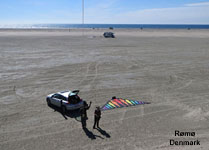
| Denmark and Poland J.S. and S.W. Aber |
| Introduction | Denmark |
| Udbyneder | Ramme Dige |
| Hurup beach | Poland |
| Margonin | Related sites |

| Denmark and Poland J.S. and S.W. Aber |
| Introduction | Denmark |
| Udbyneder | Ramme Dige |
| Hurup beach | Poland |
| Margonin | Related sites |
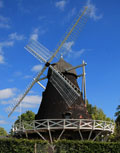
| Restored traditional windmills at Gylling, Denmark (left) and near Czarnków, Poland (right). Such mills were utilized since Medieval times until the beginning of the twentieth century. | 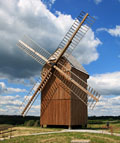 |

| Windmills built by Poul la Cour for generating electricity at Askov in southwestern Denmark (left). First mill was erected in 1891 and the larger mill was built in 1897. Note person for scale beside larger windmill. Photo dates from about 1900; from a postcard obtained at the Danish Energy Museum. The Poul la Cour Museum (right) is housed in the preserved base of the larger windmill. | 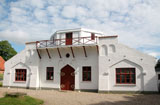 |
In the 1970s and 1980s, Danish wind energy underwent revolutionary development as exemplfied by the famous Tvind wind turbine. The 2.0 MW turbine was completed in 1978. It represents the core technology and decisive breakthrough for Danish wind turbines (Maegaard 2009). In that same year, the Danish Wind Turbine Owner’s Association was established, which encouraged sharing of technology by inventors and self-builders using diverse materials, varied construction techniques, and numerous turbine and blade designs.
Vestas, Bonus, Nordex, Nordtank, and Micon became the major Danish manufacturers of wind turbines during the 1980s. Bonus was later acquired by Siemens, and Nordex moved to Germany in 1992. Nordtank merged with Micon into NEG Micon, which was eventually bought out by Vestas, the world's largest wind-turbine company. Vestas continues to lead all other companies in manufacturing wind turbines as of 2022 with approximately one-sixth of the global market according to BizVibe.

| New Vestas world headquarters opened in 2011 at Aarhus, Denmark. Main administrative building (left) and research building (right). | 
|
Udbyneder wind farm
A substantial wind farm is located on the eastern side of Jylland near the Kattegat coast. Mariager Fjord and the city of Hobro are nearby. The area of the wind farm is low-lying land drained by a network of ditches and used primarily for agricultural crops. Bright yellow fields are raps oil (canola). Other fields contain varieties of wheat, barley, and rye grains as well as hay. The wind farm includes NEG Micon and Siemens turbines positioned in a grid system.
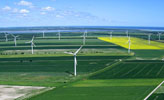
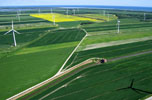
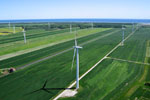
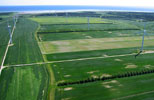
Ramme Dige archaeological site
Ramme Dige is an archaeological complex in western Jylland that contains several burial mounds from the Neolithic (late Stone Age) and Bronze Age as well as remains of a defensive wall (dige) built during the Iron Age. Many more burial mounds once existed, but some have been removed. Nonetheless, the positions of these former mounds are clearly depicted in our images. Wind turbines are visible in the background inland from the North Sea. We conducted KAP at this site once before in the autumn of 2005—see Ramme Dige.